English version
Greetings to all of you. This time I bring you a somewhat peculiar recipe. It is well known that everything is used from beef, from the legs to the eyes. For today's recipe we will use a part or cut, or whatever you prefer to call it, of the beef; yes, as the title says, I am referring to the beef tongue.
On more than one occasion I have heard some people look down on this part of the beef, because of its appearance before preparing it; often it does not provoke much but the truth is that you can make very tasty recipes with it. I had already tried it, but I had never cooked it, so today I would like to share with you my first time cooking beef tongue.

Both my mother and the internet recommended me to wash the tongue well before cooking it, so that's what I did. It is not necessary to use soap, I am not referring to that type of washing, but to use plenty of water to clean it well.
Once this is done, you have to put it in water to boil with a little salt. In my case it took a little more than 2 hours to be ready. Below is a photo of the tongue once cooked.
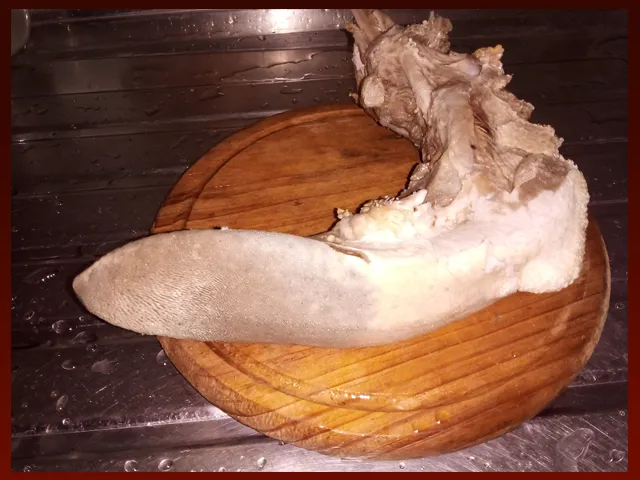
This tongue I wanted to prepare it stewed style, in a tomato stew that, after tasting the final result, suited it very well. What we need for this stew is the following:
*Onion
*Tomato
*Garlic
*Rosemary
*Dried oregano

I added all these ingredients to a pot with a little oil. First I added the onion, then the tomatoes and finally the spices and seasonings.
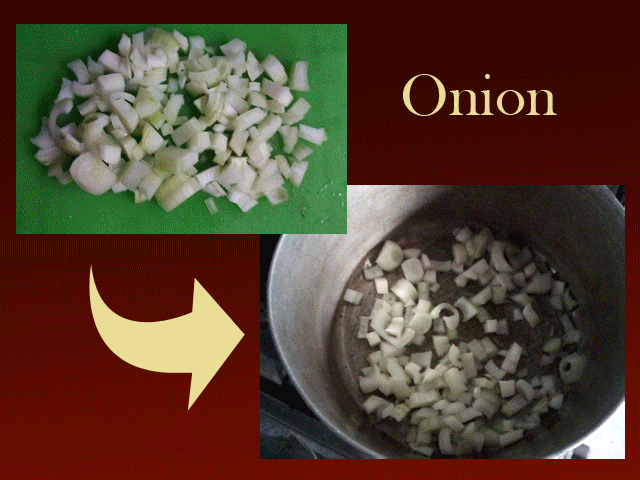
I added a little water to the preparation and cooked it for about 15 minutes, then blended it very briefly until it had the texture of a sauce.
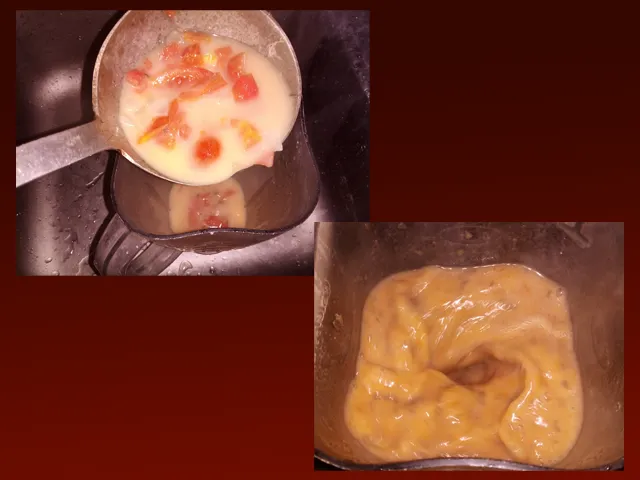
After blending, pour all the broth back into the pot to continue. In this broth will be where the tongue that we previously boiled will be cooked.
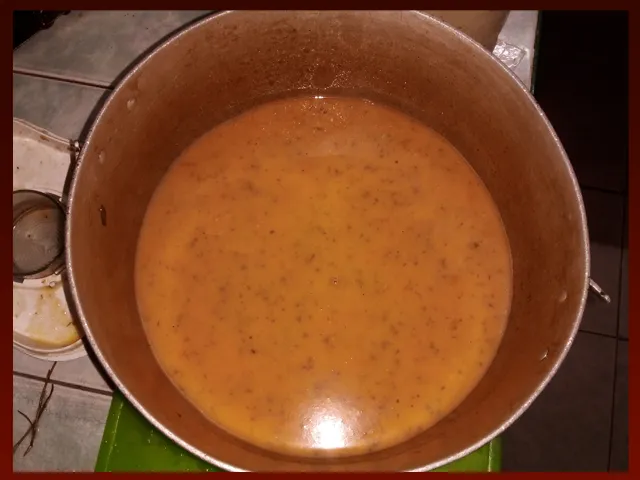
However, the beef tongue will not be able to absorb all this because it has a very thick layer that does not allow it, so always, I repeat, always, this thick and rustic layer must be removed.
It should come out easily with the help of a knife if it is well cooked, otherwise, continue boiling it in water until it is quite tender.

After removing the thick layer that covers the tongue, I cut it into several pieces and let it cook for about 20 minutes in my broth. I removed the salt and that's how easy my recipe was.

I could stop here, but this was for lunch, so I had to make a few side dishes. In my case I made a salad, some rice and the inevitable Venezuelan arepas.
For the salad I used the following ingredients:
*Papa
*Carrot
*Cabbage
*Egg
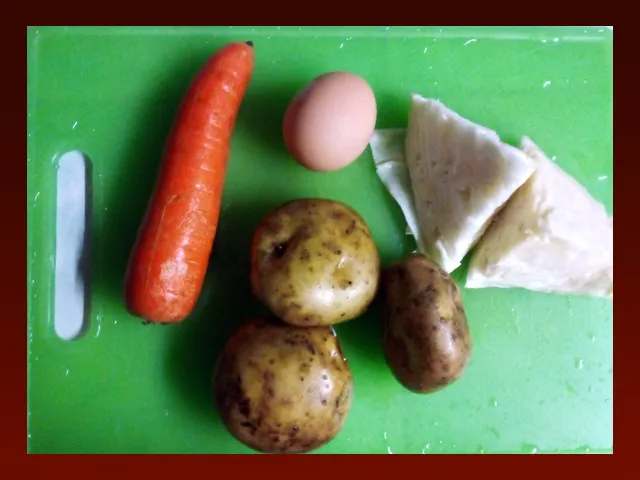
Once the vegetables were well washed, I removed the peel and cut them into small pieces, as shown in the image below:

In another pot, a little smaller than the one I used for the tongue, I boiled the carrot and the potato, with a little salt to taste.
The cabbage, on the other hand, I left it soaking in water with vinegar for about 20 minutes. Finally, I boiled an egg and cut it into small pieces.
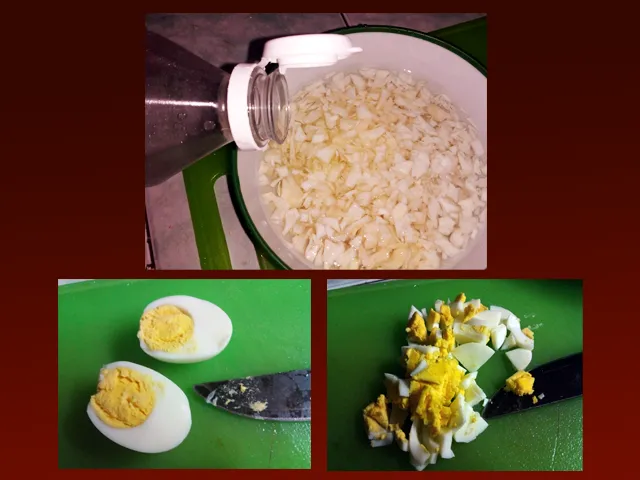
This salad is as easy as mixing all the ingredients mentioned above, adjusting the salt and adding a little sugar. It's ready.

Not everyone knows how to make arepas, so here I will explain briefly how to make them.
You have to add enough flour in a bowl, then add water gradually until the mixture is homogeneous, firm and not at all sticky.
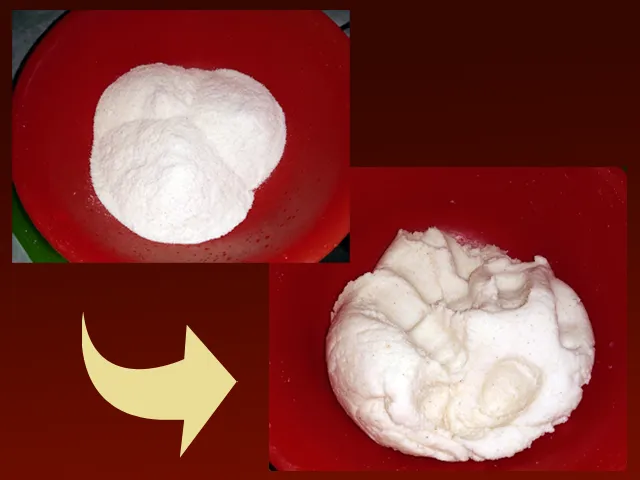
After this we make round buns and flatten them carefully using our hands. Finally we place them in a frying pan or on a griddle to cook over low heat. Here you can see an animation of these last steps:
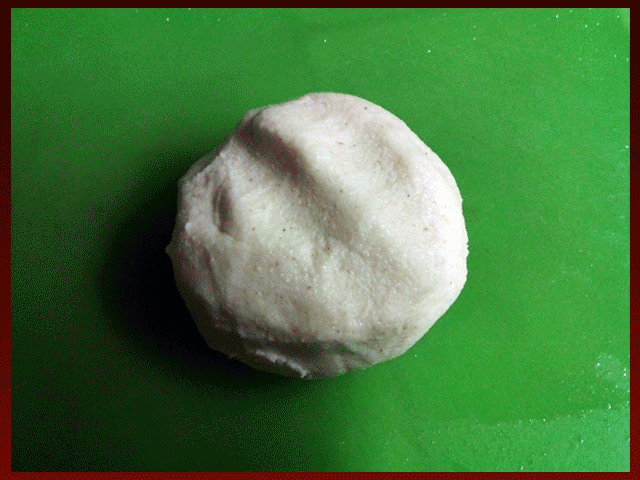
Cook until the arepa is well toasted, with an appearance similar to the image below:
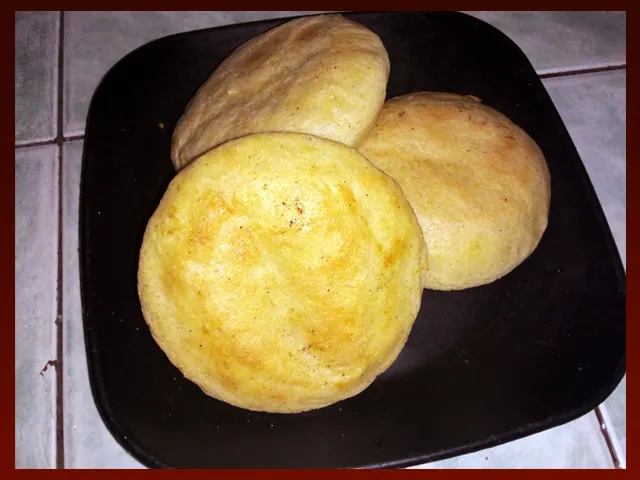
I am not going to explain how to make the rice, because it is a white rice of all life. It is simply add two cups of water for each cup of rice and cook over low heat.
Now, back to the tongue, there are many ways to serve it. You can eat it in steaks, cut it with the stew, or break it into pieces. Come on, you can even take one of the arepas and stuff it with all the things we prepare here.
Take a look at an example:
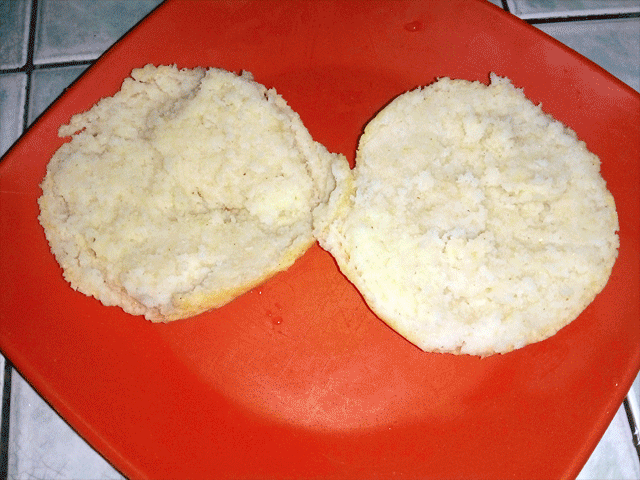
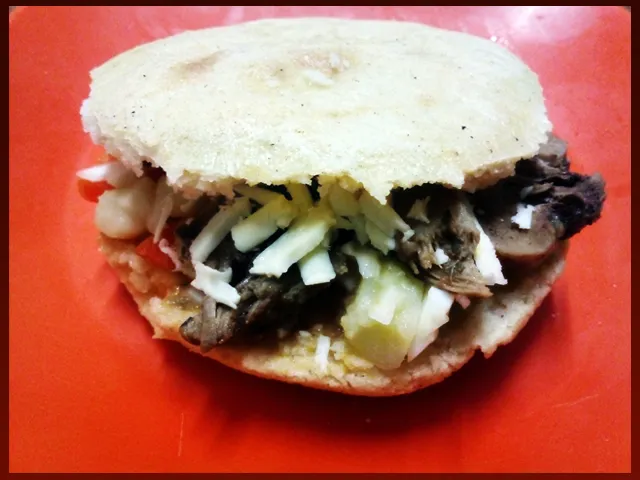
It's a great bite, but since it's a lunch I prefer it as follows, with everything we prepared. The rice together with the salad, a good piece of tongue cut and bathed in the broth in which it was cooked and a couple of arepas to go with it.
Even the same broth from the tongue can be used to bathe the rice a little, so that it is not so dry. Here are a couple of photos of the result:


What did you think? Do you dare to prepare beef tongue? Despite its initial appearance, the truth is that it is very rich and has a very pleasant texture, so don't limit yourself. In the end, it depends on each person's taste.
Well friends, for me it has been a pleasure to have shared this recipe with you. You can leave your opinions below in the comments, as always, I will be happy to read them. Without further ado, I will say goodbye then....
See you next time!
Versión en español
Saludos a todos, compañeros. En esta ocasión les traigo una receta un tanto peculiar. Es bien sabido que de la res se aprovecha todo, desde las patas hasta los ojos. Para la receta que hoy nos ocupa usaremos una parte o corte, o como prefieran llamarlo, de la res; sí, como dice el título, me refiero a la lengua de la res.
En más de una ocasióm he escuchado a algunas personas ver con mala cara esta parte de la res, por su aspecto antes de preparala; con frecuencia no provoca mucho pero lo cierto es que se pueden hacer recetas muy ricas con esto. Yo ya la había probado, pero nunca la había cocinado, así que hoy me gustaría compartir con ustedes mi primera vez cocinando lengua de res.

Tanto mi madre, como internet, me recomendaron lavar bien la lengua antes de cocinarla, así que eso hice. No es necesario usar jabón, no me refiero a ese tipo de lavado, sino a usar abundante agua para limpiarla bien.
Una vez hecho esto, hay que ponerla en agua a hervir con un poco de sal. En mi caso tardó poco más de 2 horas para estar lista. A continuación una foto de la lengua una vez cocida.

Esta lengua la quise preparar estilo guisada, en un guiso de tomates que, tras haber probado el resultado final, le vino muy bien. Lo que necesitamos para este guiso es lo siguiente:
*Cebolla
*Tomate
*Ají
*Ájo
*Romero
*Orégano seco

Todos estos ingredientes los agregué a una olla con un poco de aceite. Primero agregué la cebolla, luego los tomates y por último las especias y condimentos.

Agregué un poco de agua a la preparación y la cociné por unos 15 minutos, luego lo licué de manera muy breve, hasta que quedó con la textura de una salsa.

Tras licuar, vertí todo el caldo de nuevo a la olla para continuar. En este caldo será donde se termine de cocinar la lengua que anter hervimos.

En el caldo ya preparado es donde está todo el sabor; sin embargo, la lengua de res no podrá absorver todo esto porque tiene una capa muy gruesa que no lo permite, así que siempre, repito, siempre, se le debe quitar esta capa gruesa y rústica.
Debería salir fácil con ayuda de un cuchillo si está bien cocida, caso contrario, hay que seguir hirviéndola en agua hasta que esté bastante tierna.

Después de quitarle la capa gruesa que cubre la lengua, la corté en varios trozos y la dejé cocinar por unos 20 minutos en mi caldo. Retifiqué la sal y así de fácil quedó mi receta.

Podría dejarlo hasta aquí, pero esto era para un almuerzo, así que debía hacer unos cuantos acompañantes. En mi caso hice una ensalada, un poco de arroz y las infaltables arepas venezolanas.
Para la ensalada ocupé los siguientes ingredientes:
*Papa
*Zanahoria
*Repollo
*Huevo

Una vez bien lavados los vegetales, les quité la cáscara y los corté en pequeños trozos, tal como se observa en la imagen a continuación:

En otra olla, un poco más pequeña que la que usé para la lengua, puse a hervir la zanahora junto a la papa, con un poco de sal a gusto.
El repollo, por otra parte, lo dejé remojando en agua con vinagre por unos 20 minutos. Finalmente sancoché un huevo y lo corté en pequeños trozos.

Esta ensalada es tan fácil como mezclar todos los ingredientes antes mencionados, rectificar la sal y agregar un poco de azucar. Ya está.

No todo el mundo sabe hacer arepas, así que aquí les explicaré de manera breve cómo se hacen.
Hay que agregar suficiente harina en un tazón, luego agregamos agua de manera gradual hasta que la mezcla esté homogénea, firme y para nada pegajosa.

Luego de esto hacemos unos bollos redondos y los aplastaremos con cuidado usando nuestras manos. Finalmente los colocamos en un sartén o en una plancha a cocinar a fuego lento. Acá pueden observar una animación de estos últimos pasos:

Se cocinan hasta que la arepa esté bien tostada, con un aspecto similar al de la imagen a continuación:

El arroz no voy a explicar cómo hacerlo, pues es un arroz blanco de toda la vida. Es simplemente agregar dos tazas de agua por cada tasa de arroz y cocinar a fuego lento.
Ahora bien, volviendo a la lengua, hay muchas maneras de servirla. Puedes comerla en filetes, cortada con el guiso o desebrarla. Vamos, que hasta puedes tomar una de las arepas y rellenarla con todas las cosas que preparamos aquí.
Mira un ejemplo:


Es un gran bocado, pero como es un almuerzo yo la prefiero de la siguiente manera, con todo lo que preparamos. El arroz junto a la ensalada, un buen pedazo de lengua cortada y bañada en el propio caldo en el que se cocinó y un par de arepas para acompañar.
Hasta el mismo caldo de la lengua se puede usar para bañar un poco el arroz, para que no quede tan seco. A continuación un par de fotos del resultado:


¿Qué te pareció? ¿Te animas a preparar lengua de res? Pese a su aspecto inicial la verdad es que es muy rica y de textura muy agradable así que no te limites. Al final, depende de los gustos de cada quien.
Bien amigos, para mi ha sido un placer haber compartido esta receta con ustedes. Pueden dejar sus opiniones abajo en los comentarios, como siempre, estaré encantado de leerlos. Sin más que agregar, me despido entonces...
¡Hasta la próxima!

Traducido con DeepL
Translated with DeepL
Gabo Play - Alto's Odyssey Gameplay
Gabo Play Megaman x4 #6
Winter Greeter Sculpture




